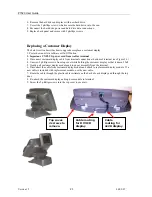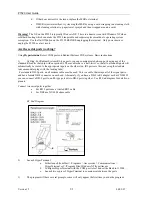
P1520 User Guide
Version 1.2
18
04/02/07
Touch Calibration
The P1520 with resistive or capacitive touch screen will already be calibrated before it ships from Radiant
Manufacturing. It should not require a recalibration through the life of the terminal. However, if touch issues
arise, it is recommended that re-calibration be tried first before returning the terminal.
A way to determine if you have resistive or capacitive touch screen is to gently touch the screen with an object
different from a finger. This could be a plastic part of a pen, cardboard, etc. Resistive screens will accept all
input devices including finger or styluses whereas capacitive will just accept finger and/or conductive input
devices. If the plastic part of the pen does not register a touch, the terminal is likely to have a capacitive touch
screen which requires finger input for best results.
Resistive touch screen
For resistive touch screen, Radiant uses 4 point calibration to achieve the best accuracy. The below steps
outline how to re-calibrate the touch screen. Note: Do not use any sharp objects, pens, pencils, or any material
expect a finger to contact touch screen sense it could damage the touch sensing layer.
With a Radiant application, from the managers menu, select
calibrate touchscreen
.
From the
desktop or startup menu
Æ
run
Æ
type:
tcalib
You can also run the tcalib from the P15xx folder.
See picture below.
\
Additional Touch settings for Resistive
Below are some variables that can be adjusted in the control panel in the P15xx Hardware to help with touch
parameters such as internet browser buttons.
Touch double-click speed settings
Go to
Hkey_current_user
Æ
control panel
Æ
mouse
Æ
doubleclickspeed
The number is the time (in milliseconds) in between clicks to register as a double-click. If it's set
extremely low, you can eliminate double-clicking altogether. For example, at the default value of 500
DoubleClickSpeed you have 1/2 a second to click twice. At 100 DoubleClickSpeed you have 1/10 of a
second, and at 1500 DoubleClickSpeed you have 1 1/2 seconds. The clicks must happen inside the
height and width restrictions, which are in pixels.
Touch drag settings
This changes the size of the area Windows uses to differentiate between a click and a drag. The user
can change the
DragWidth
and
DragHeight
to 30 pixels from the default value of 4. This prevents the
'Forbidden' symbol
;
from appearing when you try to click buttons that are made with pictures.
Capacitive touch screen






























